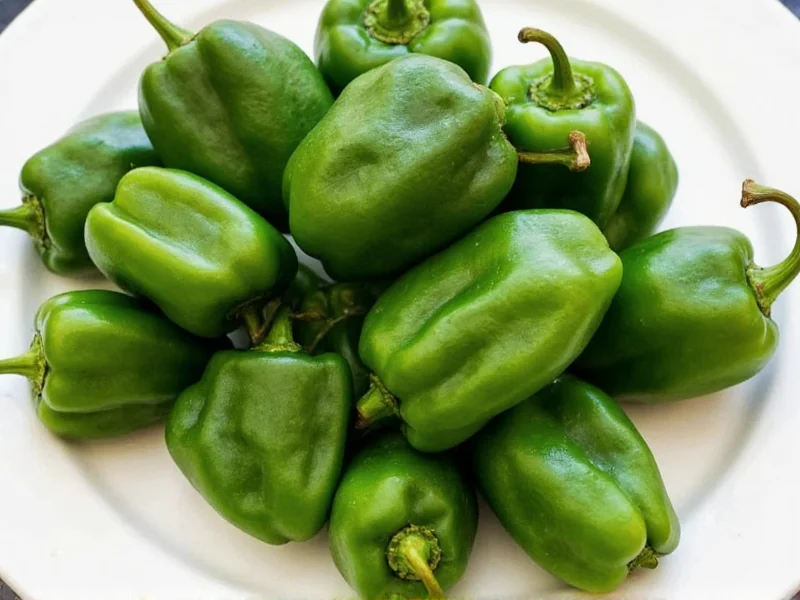Dehydrating poblano peppers preserves their distinctive mild-to-medium heat and earthy flavor for year-round culinary use. This versatile preservation method transforms fresh poblanos into ingredients perfect for soups, stews, sauces, and spice blends. Unlike jalapeños that become chipotles when smoked, dehydrated poblanos develop a deeper, more complex flavor profile while maintaining their characteristic mild heat level (1,000-2,000 Scoville units).
Why Dehydrate Poblano Peppers?
Poblano peppers, native to Mexico and central to many traditional dishes, have a relatively short fresh shelf life of 1-2 weeks. Dehydration extends their usability while concentrating flavors. Home gardeners with abundant harvests and cooks seeking authentic Mexican cuisine ingredients benefit most from this preservation technique. Dehydrated poblanos reconstitute beautifully in liquid-based dishes and grind smoothly into flavorful powders.
Preparation: The Critical First Step
Proper preparation significantly impacts your dehydrated peppers' final quality. Follow these preparation guidelines for optimal results:
- Selection: Choose firm, glossy poblanos without blemishes or soft spots. Fully mature dark green peppers dehydrate better than pale or yellowing ones.
- Cleaning: Wash thoroughly under cool running water and dry completely with a clean towel. Any moisture remaining on the skin slows the dehydration process.
- Roasting (Recommended): Roast over open flame, under broiler, or on grill until skin blisters (about 5-8 minutes). This step enhances flavor and makes peeling easier, though some prefer keeping the skin for added texture.
- Peeling: Place roasted peppers in a covered bowl for 10 minutes, then remove loosened skin. For completely smooth finished product, remove all skin.
- Slicing: Cut into uniform 1/4-inch slices, removing seeds and membranes. Consistent thickness ensures even drying.
Dehydration Methods Compared
Three primary methods exist for dehydrating poblano peppers, each with distinct advantages:
| Method | Temperature | Time Required | Energy Cost | Best For |
|---|---|---|---|---|
| Food Dehydrator | 125°F-135°F | 8-12 hours | $$ | Consistent results, large batches |
| Oven Drying | 140°F-170°F | 6-10 hours | $$$ | Those without dehydrators |
| Air Drying | Ambient | 2-3 weeks | $ | Dry climates, small batches |
Step-by-Step Dehydration Process
Using a Food Dehydrator (Recommended Method)
- Arrange prepared poblano slices in single layer on dehydrator trays without overlapping
- Set temperature to 125°F-135°F (52°C-57°C)
- Rotate trays every 2 hours for even drying
- Check for dryness after 6 hours (peppers should be brittle, not leathery)
- Continue drying in 30-minute increments until completely dry (typically 8-12 hours)
Oven Drying Method
- Preheat oven to its lowest setting (ideally 140°F-170°F)
- Place slices on wire racks over baking sheets
- Prop oven door open 2-3 inches with wooden spoon for air circulation
- Bake 6-10 hours, flipping slices halfway through
- Check frequently to prevent scorching
Air Drying Method
- Thread whole roasted peppers on sterilized string through stem ends
- Hang in well-ventilated, dry area away from direct sunlight
- Ensure good air circulation around all peppers
- Wait 2-3 weeks until peppers snap when bent
- Store immediately upon complete drying
Determining Proper Dryness
Correct dryness level prevents mold while preserving flavor. Test for complete dehydration by:
- The Snap Test: Properly dried poblano slices should break cleanly when bent, not fold or bend
- The Touch Test: They should feel completely dry with no moisture when pressed
- The Cool Down Test: Remove a sample, let cool for 5 minutes, then recheck dryness (moisture can reappear as they cool)
Under-dried peppers risk mold during storage, while over-dried peppers become brittle and lose flavor complexity. The ideal texture resembles thin, crisp autumn leaves.
Storage Techniques for Maximum Shelf Life
Proper storage maintains quality of your dehydrated poblano peppers:
- Conditioning: Before final storage, place dried peppers in airtight container for 7-10 days, shaking daily to detect any moisture buildup
- Containers: Use glass jars with oxygen absorbers, vacuum-sealed bags, or heavy-duty freezer containers
- Environment: Store in cool, dark place (below 70°F/21°C) away from heat sources
- Shelf Life: Properly stored dehydrated poblanos maintain quality for 6-12 months
- Freezing: For extended storage (up to 2 years), freeze in airtight containers after dehydration
Culinary Applications for Dehydrated Poblano Peppers
Dehydrated poblanos offer versatile culinary uses:
- Rehydration: Soak in hot water for 20-30 minutes before using in sauces, stews, or soups
- Pepper Powder: Grind completely dry peppers in spice grinder for homemade ancho chili powder (note: dried poblanos are technically called ancho peppers)
- Flakes: Break dried peppers into flakes for pizza topping or seasoning blends
- Infused Oils: Add dried slices to olive oil for flavorful cooking oil
- Direct Use: Add whole dried peppers to bean dishes for gradual flavor infusion
Troubleshooting Common Dehydration Issues
Mold Development During Drying
If mold appears during dehydration, discard affected peppers immediately. Prevent mold by:
- Ensuring complete dryness of peppers before starting
- Maintaining proper air circulation
- Keeping dehydration temperature above 125°F
- Rotating trays regularly
Uneven Drying
When some pieces dry faster than others:
- Ensure uniform slice thickness (1/4 inch ideal)
- Rotate trays periodically
- Avoid overcrowding dehydrator trays
- Place thicker pieces toward dehydrator's center
Flavor Loss
To preserve maximum flavor:
- Avoid temperatures above 135°F
- Store away from light and heat
- Use within 6 months for peak flavor
- Consider vacuum sealing with oxygen absorbers











 浙公网安备
33010002000092号
浙公网安备
33010002000092号 浙B2-20120091-4
浙B2-20120091-4